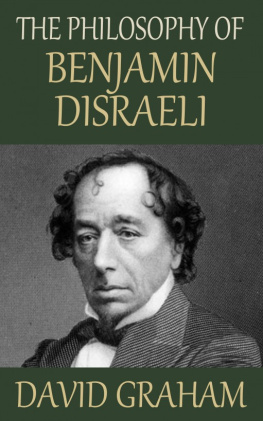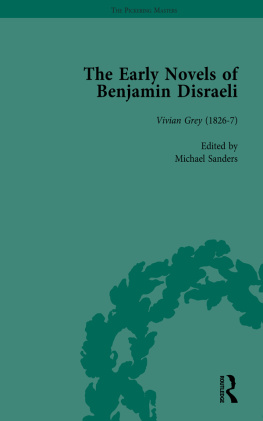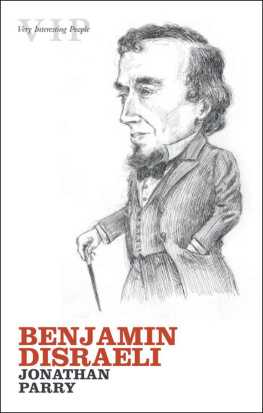Earl of Beaconsfield Benjamin Disraeli - Henrietta Temple: A Love Story
Here you can read online Earl of Beaconsfield Benjamin Disraeli - Henrietta Temple: A Love Story full text of the book (entire story) in english for free. Download pdf and epub, get meaning, cover and reviews about this ebook. year: 2006, genre: Art. Description of the work, (preface) as well as reviews are available. Best literature library LitArk.com created for fans of good reading and offers a wide selection of genres:
Romance novel
Science fiction
Adventure
Detective
Science
History
Home and family
Prose
Art
Politics
Computer
Non-fiction
Religion
Business
Children
Humor
Choose a favorite category and find really read worthwhile books. Enjoy immersion in the world of imagination, feel the emotions of the characters or learn something new for yourself, make an fascinating discovery.
- Book:Henrietta Temple: A Love Story
- Author:
- Genre:
- Year:2006
- Rating:4 / 5
- Favourites:Add to favourites
- Your mark:
- 80
- 1
- 2
- 3
- 4
- 5
Henrietta Temple: A Love Story: summary, description and annotation
We offer to read an annotation, description, summary or preface (depends on what the author of the book "Henrietta Temple: A Love Story" wrote himself). If you haven't found the necessary information about the book — write in the comments, we will try to find it.
Henrietta Temple: A Love Story — read online for free the complete book (whole text) full work
Below is the text of the book, divided by pages. System saving the place of the last page read, allows you to conveniently read the book "Henrietta Temple: A Love Story" online for free, without having to search again every time where you left off. Put a bookmark, and you can go to the page where you finished reading at any time.
Font size:
Interval:
Bookmark:
The Project Gutenberg EBook of Henrietta Temple, by Benjamin Disraeli
This eBook is for the use of anyone anywhere at no cost and with
almost no restrictions whatsoever. You may copy it, give it away or
re-use it under the terms of the Project Gutenberg License included
with this eBook or online at www.gutenberg.org
Title: Henrietta Temple
A Love Story
Author: Benjamin Disraeli
Release Date: November 12, 2006 [EBook #19771]
Last Updated: November 3, 2012
Language: English
*** START OF THIS PROJECT GUTENBERG EBOOK HENRIETTA TEMPLE ***
Produced by David Widger
Earl of Beaconsfield
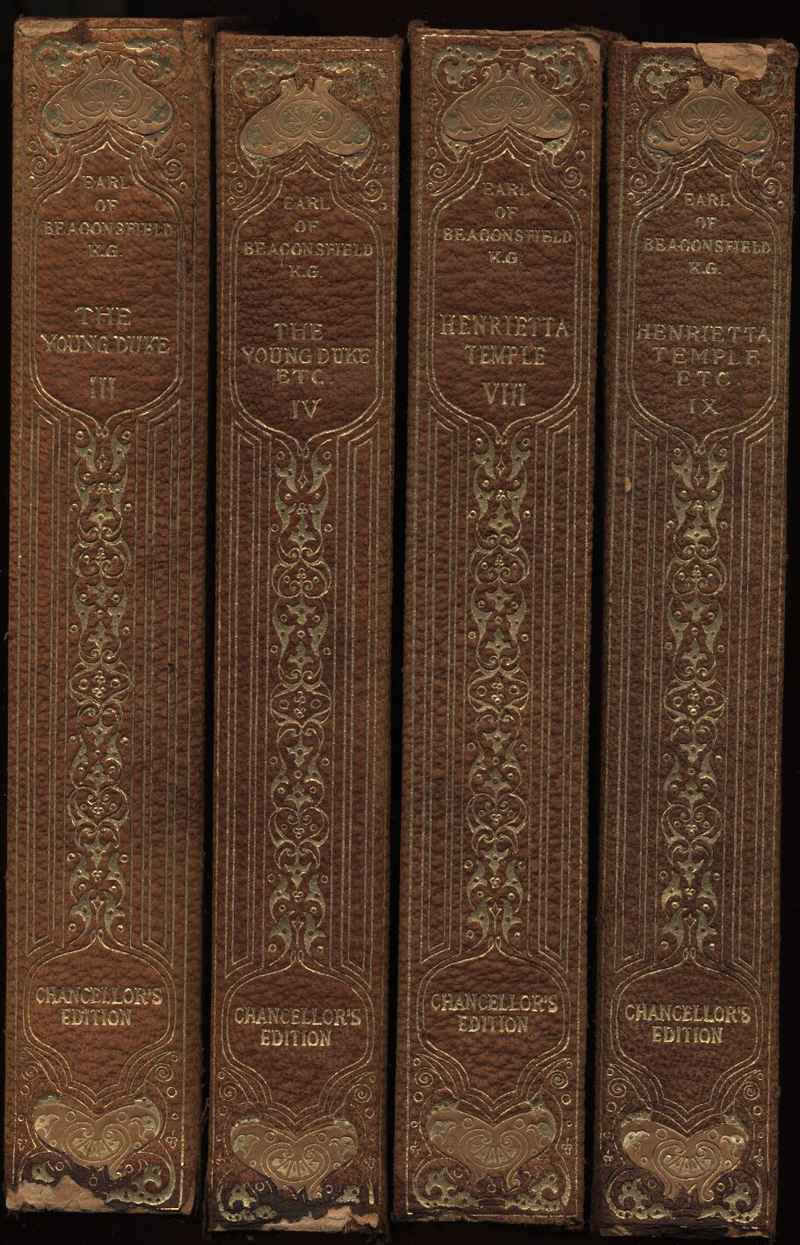
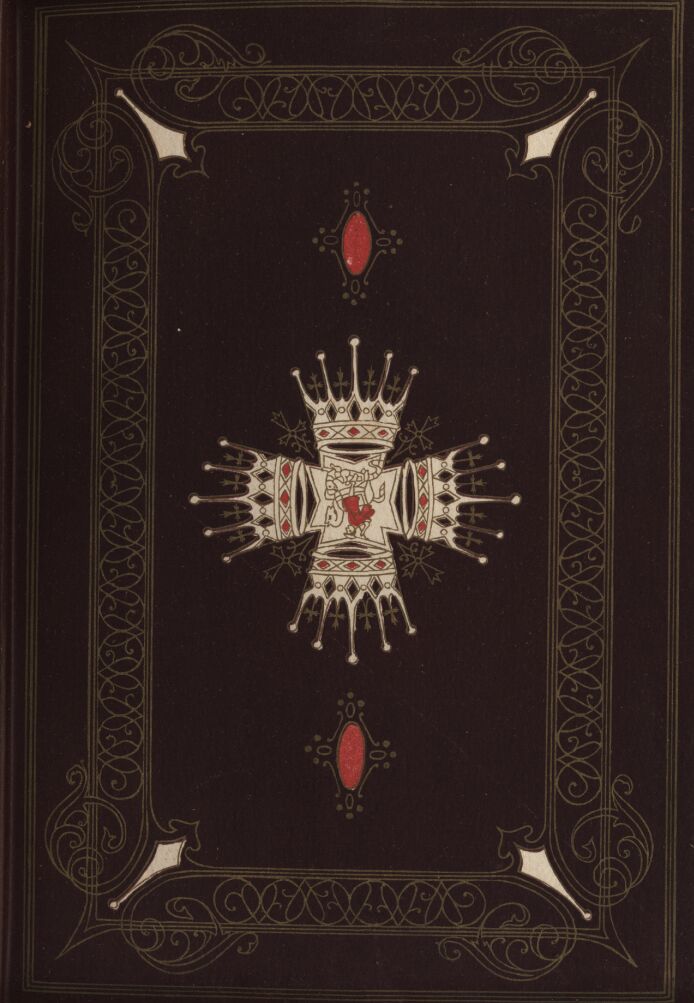
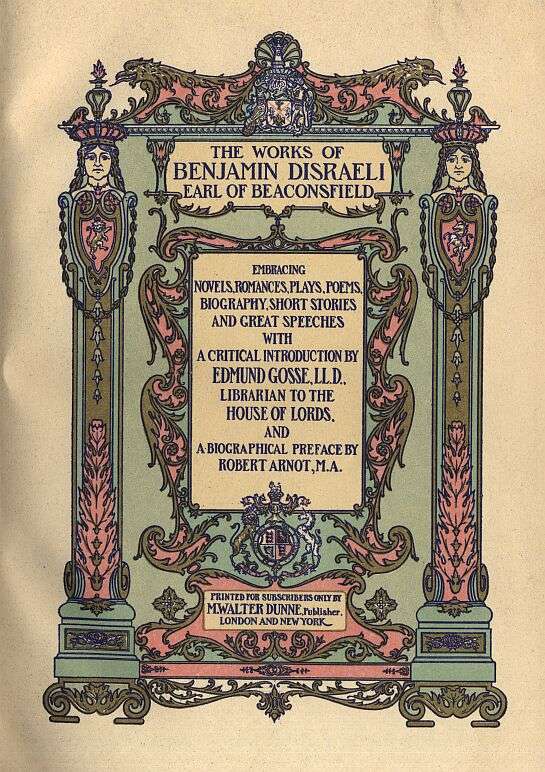
THESE VOLUMES ARE INSCRIBED
BY
HIS AFFECTIONATE FRIEND.
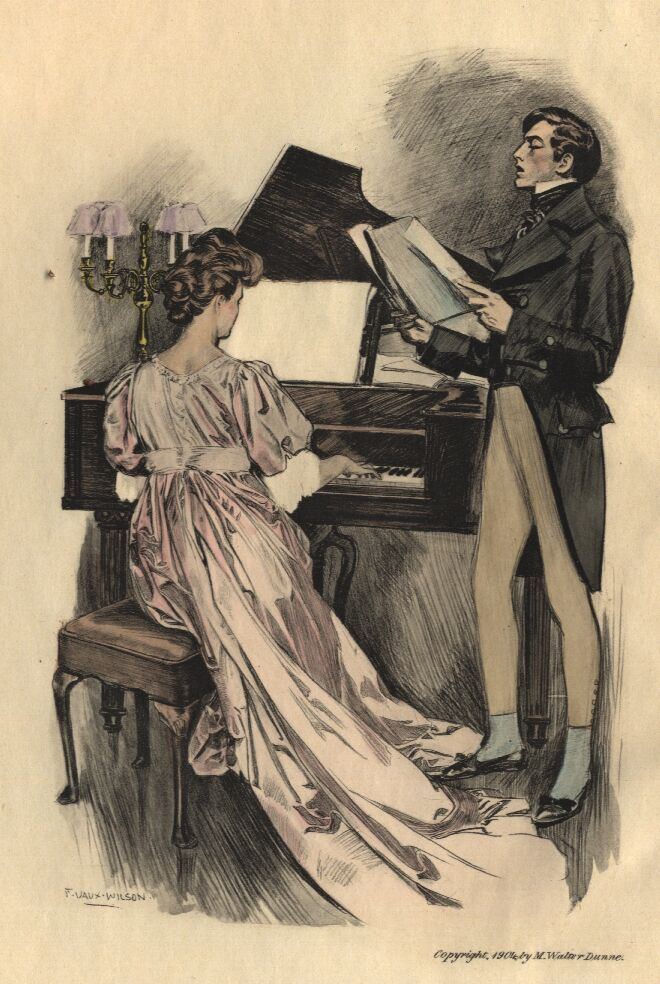


CONTENTS
ILLUSTRATIONS
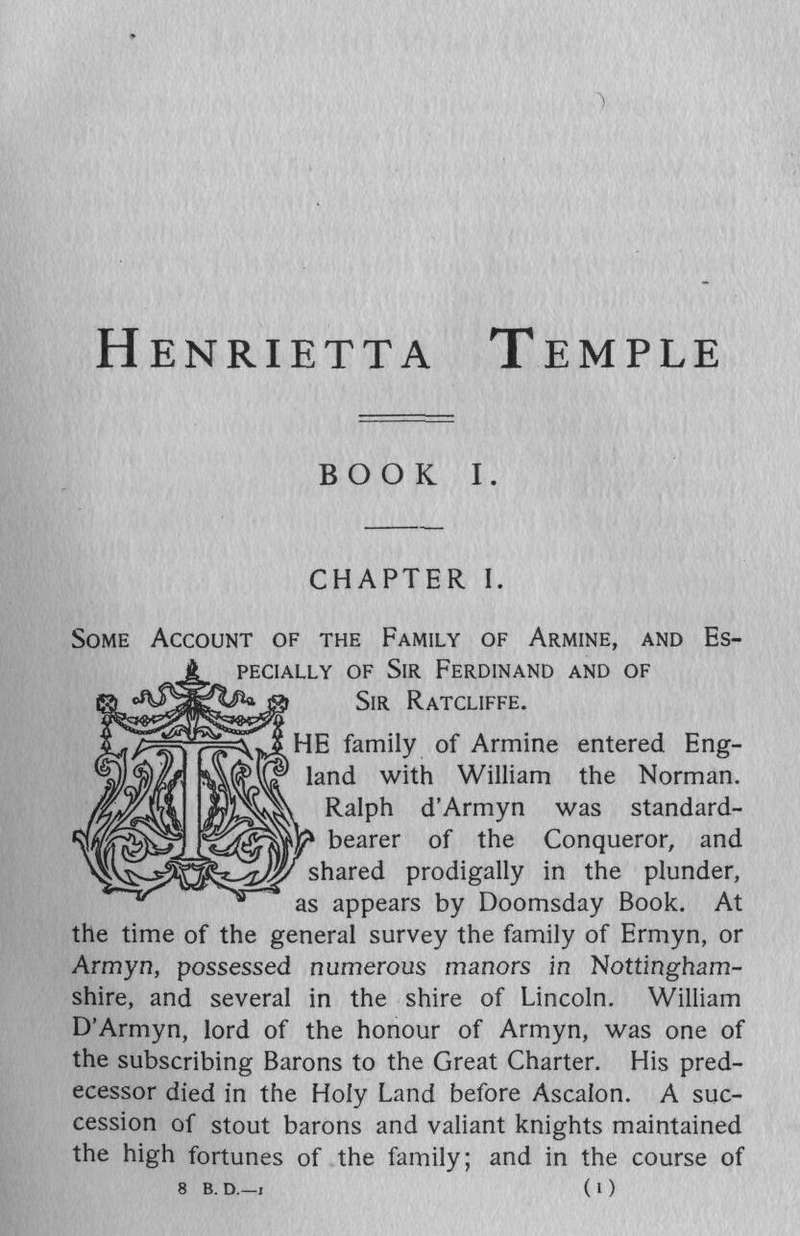
Especially of Sir Ferdinand and of Sir Ratcliffe.
THE family of Armine entered England with William the Norman. Ralph d'Armyn was standard-bearer of the Conqueror, and shared prodigally in the plunder, as appears by Doomsday Book. At the time of the general survey the family of Ermyn, or Armyn, possessed numerous manors in Nottinghamshire, and several in the shire of Lincoln. William D'Armyn, lord of the honour of Armyn, was one of the subscribing Barons to the Great Charter. His predecessor died in the Holy Land before Ascalon. A succession of stout barons and valiant knights maintained the high fortunes of the family; and in the course of the various struggles with France they obtained possession of several fair castles in Guienne and Gascony. In the Wars of the Roses the Armyns sided with the house of Lancaster. Ferdinand Armyn, who shared the exile of Henry the Seventh, was knighted on Bosworth Field, and soon after created Earl of Tewkesbury. Faithful to the Church, the second Lord Tewkesbury became involved in one of those numerous risings that harassed the last years of Henry the Eighth. The rebellion was unsuccessful, Lord Tewkesbury was beheaded, his blood attainted, and his numerous estates forfeited to the Crown. A younger branch of the family, who had adopted Protestantism, married the daughter of Sir Francis Walsingham, and attracted, by his talents in negotiation, the notice of Queen Elizabeth. He was sent on a secret mission to the Low Countries, where, having greatly distinguished himself, he obtained on his return the restoration of the family estate of Armine, in Nottinghamshire, to which he retired after an eminently prosperous career, and amused the latter years of his life in the construction of a family mansion, built in that national style of architecture since described by the name of his royal mistress, at once magnificent and convenient. His son, Sir Walsingham Armine, figured in the first batch of baronets under James the First.
During the memorable struggle between the Crown and the Commons, in the reign of the unhappy Charles, the Armine family became distinguished Cavaliers. The second Sir Walsingham raised a troop of horse, and gained great credit by charging at the head of his regiment and defeating Sir Arthur Haselrigg's Cuirassiers. It was the first time that that impenetrable band had been taught to fly; but the conqueror was covered with wounds. The same Sir Walsingham also successfully defended Armine House against the Commons, and commanded the cavalry at the battle of Newbury, where two of his brothers were slain. For these various services and sufferings Sir Walsingham was advanced to the dignity of a baron of the realm, by the title of Lord Armine, of Armine, in the county of Nottingham. He died without issue, but the baronetcy devolved on his youngest brother, Sir Ferdinando.
The Armine family, who had relapsed into popery, followed the fortunes of the second James, and the head of the house died at St. Germain. His son, however, had been prudent enough to remain in England and support the new dynasty, by which means he contrived to secure his title and estates. Roman Catholics, however, the Armines always remained, and this circumstance accounts for this once-distinguished family no longer figuring in the history of their country. So far, therefore, as the house of Armine was concerned, time flew during the next century with immemorable wing. The family led a secluded life on their estate, intermarrying only with the great Catholic families, and duly begetting baronets.
At length arose, in the person of the last Sir Ferdinand Armine, one of those extraordinary and rarely gifted beings who require only an opportunity to influence the fortunes of their nation, and to figure as a Csar or an Alcibiades. Beautiful, brilliant, and ambitious, the young and restless Armine quitted, in his eighteenth year, the house of his fathers, and his stepdame of a country, and entered the Imperial service. His blood and creed gained him a flattering reception; his skill and valour soon made him distinguished. The world rang with stories of his romantic bravery, his gallantries, his eccentric manners, and his political intrigues, for he nearly contrived to be elected King of Poland. Whether it were disgust at being foiled in this high object by the influence of Austria, or whether, as was much whispered at the time, he had dared to urge his insolent and unsuccessful suit on a still more delicate subject to the Empress Queen herself, certain it is that Sir Ferdinand suddenly quitted the Imperial service, and appeared at Constantinople in person. The man whom a point of honour prevented from becoming a Protestant in his native country had no scruples about his profession of faith at Stamboul: certain it is that the English baronet soon rose high in the favour of the Sultan, assumed the Turkish dress, conformed to the Turkish customs, and finally, led against Austria a division of the Turkish army. Having gratified his pique by defeating the Imperial forces in a sanguinary engagement, and obtaining a favourable peace for the Porte, Sir Ferdinand Armine doffed his turban, and suddenly reappeared in his native country. After the sketch we have given of the last ten years of his life, it is unnecessary to observe that Sir Ferdinand Armine immediately became what is called fashionable; and, as he was now in Protestant England, the empire of fashion was the only one in which the young Catholic could distinguish himself. Let us then charitably set down to the score of his political disabilities the fantastic dissipation and the frantic prodigality in which the liveliness of his imagination and the energy of his soul exhausted themselves. After three startling years he married the Lady Barbara Ratcliffe, whose previous divorce from her husband, the Earl of Faulconville, Sir Ferdinand had occasioned. He was, however, separated from his lady during the first year of their more hallowed union, and, retiring to Rome, Sir Ferdinand became apparently devout. At the end of a year he offered to transfer the whole of his property to the Church, provided the Pope would allow him an annuity and make him a cardinal. His Holiness not deeming it fit to consent to the proposition, Sir Ferdinand quitted his capital in a huff, and, returning to England, laid claim to the peerages of Tewkesbury and Armine. Although assured of failing in these claims, and himself perhaps as certain of ill success as his lawyers, Sir Ferdinand nevertheless expended upwards of 60,000L. in their promotion, and was amply repaid for the expenditure in the gratification of his vanity by keeping his name before the public. He was never content except when he was astonishing mankind; and while he was apparently exerting all his efforts to become a King of Poland, a Roman cardinal, or an English peer, the crown, the coronet, and the scarlet hat were in truth ever secondary points with him, compared to the sensation throughout Europe which the effort was contrived and calculated to ensure.
Font size:
Interval:
Bookmark:
Similar books «Henrietta Temple: A Love Story»
Look at similar books to Henrietta Temple: A Love Story. We have selected literature similar in name and meaning in the hope of providing readers with more options to find new, interesting, not yet read works.
Discussion, reviews of the book Henrietta Temple: A Love Story and just readers' own opinions. Leave your comments, write what you think about the work, its meaning or the main characters. Specify what exactly you liked and what you didn't like, and why you think so.



